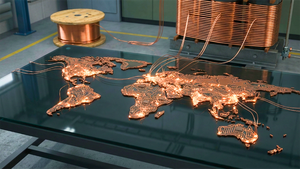
Industrial manufacturing company Ingersoll Rand (NYSE: IR) announced better-than-expected revenue in Q2 CY2025, with sales up 4.6% year on year to $1.89 billion. Its non-GAAP profit of $0.80 per share was in line with analysts’ consensus estimates.
Is now the time to buy IR? Find out in our full research report (it’s free).
Ingersoll Rand (IR) Q2 CY2025 Highlights:
- Revenue: $1.89 billion vs analyst estimates of $1.84 billion (4.6% year-on-year growth, 2.4% beat)
- Adjusted EPS: $0.80 vs analyst estimates of $0.80 (in line)
- Adjusted EBITDA: $509.4 million vs analyst estimates of $505.2 million (27% margin, 0.8% beat)
- Management raised its full-year Adjusted EPS guidance to $3.40 at the midpoint, a 1.8% increase
- EBITDA guidance for the full year is $2.13 billion at the midpoint, above analyst estimates of $2.1 billion
- Operating Margin: 4%, down from 15.1% in the same quarter last year
- Organic Revenue fell 3.4% year on year vs analyst estimates of 4.1% declines (67.6 basis point beat)
- Market Capitalization: $31.17 billion
StockStory’s Take
Ingersoll Rand’s second quarter results were met with a sharply negative market reaction, reflecting investor concern over the company’s margin pressures and muted organic revenue trends. Management attributed the quarter’s performance to a combination of lower organic volumes, ongoing impacts from tariffs, and the dilutive effect of recent acquisitions. CEO Vicente Reynal highlighted, “the year-over-year decline in adjusted EBITDA margin was driven primarily by the flow-through on organic volume declines, the dilutive impact from recently acquired businesses, [and] the dilutive impact of tariff pricing.” The team also pointed to continued investment in growth initiatives and resilience in certain product segments, though overall demand growth remained modest.
Looking ahead, Ingersoll Rand’s updated full-year guidance rests on expectations of improved order conversion, benefits from recent acquisitions, and gradual margin recovery as integration progresses. Management cited a healthy backlog and stable business conditions but remained cautious given ongoing tariff uncertainty and delayed customer decision-making. CFO Vik Kini noted, “We do expect to see sequential margin improvement, with Q4 being the high watermark for the year,” while Reynal added that greater clarity around tariffs and tax incentives could unlock pent-up demand. The company’s strategy emphasizes disciplined capital allocation and continued expansion in aftermarket and recurring revenue streams.
Key Insights from Management’s Remarks
Management identified several core factors influencing the quarter’s performance, including order trends, margin dynamics, and the evolving impact of tariffs and acquisitions.
- Tariffs and pricing: Ongoing tariff fluctuations created unpredictability for both customers and Ingersoll Rand’s pricing strategy. Management explained that tariff-related pricing was offsetting higher costs one-for-one, but this mechanism contributed to gross margin pressure and uncertainty in demand conversion.
- Acquisition integration challenges: The company closed 11 acquisitions year-to-date, with a focus on bolt-on deals to expand technology and geographic reach. However, recent acquisitions, particularly ILC Dover, led to non-cash impairments and short-term margin dilution. Management emphasized their disciplined approach, including insurance-backed representations and warranties to mitigate risk.
- Aftermarket and recurring revenue progress: Aftermarket revenue rose to 37% of the total, up 100 basis points year-over-year, reflecting management’s push to grow higher-margin, recurring service streams. This trend is seen as a partial buffer against cyclicality in new equipment demand.
- Product innovation: Major product launches included the CompAir Ultima oil-free compressor with improved energy efficiency and the EVO Series electric diaphragm pump. These launches are positioned to drive future efficiency gains and recurring service opportunities.
- Orders and end-market trends: Organic order growth was strongest in industrial vacuum, blowers, and certain regional markets like China, where demand generation initiatives yielded positive results despite broader market sluggishness. Management called out resilience in water infrastructure and the life sciences segment as relative bright spots.
Drivers of Future Performance
Ingersoll Rand’s forward outlook is shaped by tariff resolution, backlog conversion, and further integration of recent acquisitions, with margin recovery hinging on stable pricing and productivity gains.
- Tariff uncertainty and customer decision delays: Management stated that clarity on tariff policies is critical for unlocking delayed customer investment. Reynal explained that customers are “waiting a few more weeks or a few more months to complete this holistic picture,” indicating that near-term demand could remain suppressed until policy is finalized.
- Backlog and order funnel: The company’s healthy backlog and robust book-to-bill ratio should support revenue conversion in the second half of the year. Management expects large long-cycle orders, especially in ITS (Industrial Technologies & Services), to begin materializing in 2026 revenue, with current momentum in water, wastewater, and select Asia-Pacific markets.
- Margin improvement drivers: Sequential margin expansion is expected from seasonally higher revenues, productivity initiatives, and ongoing acquisition integration. Kini highlighted that pricing actions are already in place and that further improvement will depend on volume stabilization and successful execution of the M&A playbook.
Catalysts in Upcoming Quarters
In the coming quarters, the StockStory team will closely watch (1) how quickly tariff-related uncertainty is resolved and whether this leads to a rebound in customer orders, (2) the pace and success of integrating recent acquisitions, particularly within life sciences and compressor segments, and (3) progress in expanding aftermarket and recurring revenue streams. Execution on these fronts will be critical for margin recovery and long-term stability.
Ingersoll Rand currently trades at $78.40, down from $84.70 just before the earnings. Is there an opportunity in the stock?Find out in our full research report (it’s free).
Stocks That Trumped Tariffs
Trump’s April 2025 tariff bombshell triggered a massive market selloff, but stocks have since staged an impressive recovery, leaving those who panic sold on the sidelines.
Take advantage of the rebound by checking out our Top 9 Market-Beating Stocks. This is a curated list of our High Quality stocks that have generated a market-beating return of 183% over the last five years (as of March 31st 2025).
Stocks that made our list in 2020 include now familiar names such as Nvidia (+1,545% between March 2020 and March 2025) as well as under-the-radar businesses like the once-micro-cap company Kadant (+351% five-year return). Find your next big winner with StockStory today.
StockStory is growing and hiring equity analyst and marketing roles. Are you a 0 to 1 builder passionate about the markets and AI? See the open roles here.




